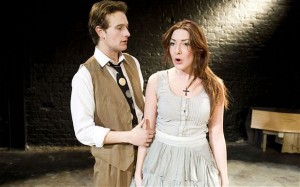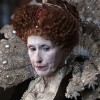Fake Shakes(peare)
written for The Spectator, 1 February 2011
Plaster the name ‘William Shakespeare’ on your theatre posters, and you’re sure to get bums on seats – even if Shakespeare didn’t quite write the play in question. That’s the rationale behind the slew of productions of the mysterious Cardenio, or Double Falsehood, the latest of which has opened at the Union Theatre. This latest production is fresh and pacy – and buoyed by energetic performances by Emily Plumtree, Emily Plumtree and Adam Redmore – but it’s hard to watch without a gnawing sense of astonishment at the chutzpah of the company’s claim to place this flimsy curio alongside masterpieces like Macbeth or Measure for Measure.
There are few global brands as successful as William Shakespeare. Setting aside that the man himself left for us the subtlest, richest traces of the human imagination ever to stamp their imprint on our shared consciousness, the name represents a powerful set of marketable values. The Shakespeare brand is, today, both aspirational and universal – sticking his face on your fridge marks you as learned enough to know your 16th century vocabulary, but sensitive enough of soul to understand everything from ‘the milk of human kindness’ to ‘a mind diseased’. His penetrating gaze is the perfect logo for our touchy-feely age, which may not be a coincidence, since our modern interest in human interiority was almost invented by the power of Shakespeare’s soliloquies. And the sheer range of characters means there’s something to sell to everyone.

Adam Redmore and Jessie Lilley in Double Falsehood at the Union Theatre
Ever since Ben Jonson’s eulogy lauded his rival as ‘not of an age, but for all time’, Shakespeare has been celebrated for his ability to express the universal range of human emotions. Hamlet imagines that the theatre should ‘hold a mirror up to nature’ and, in a hugely influential passage, Samuel Johnson advertised Shakespeare as the poet who fulfilled his own challenge: ‘the poet who holds up to his readers a faithful mirror of manners and of life… not modified by the customs of particular places’. So you can send your romantic Indonesian aunt a coffee mug with a quotation from Romeo and Juliet, and next to it in the shop find a King Lear version to buy for your Emo teenage niece in Moscow. Perfect.
With images of the Bard’s face sold on coasters from Tokyo to Torquay, what matter if no expert can agree on what he actually looked like? Give him the right mutton chops and stringy mustache, stick a pen in his hand – or better, a skull – and the average consumer will recognize what Shakespeare ought to look like better than any university don. The Shakespeare industry has been up to this trick for hundreds of years, producing spurious portraits supposedly of the man himself. According to one curator, ‘there are between 50 and 100 images in the National Portrait Gallery stacks that were at one time considered to be him’. So it’s no surprise that the publishing industry, the beating heart of Shakespeare Inc. with 4 billion copies of his work sold, has occasionally pulled off a similar trick. What makes Double Falsehood stand out amongst the many doubtful texts that have through history claimed Shakespeare as an author is the level of scholarship that’s gone into verifying the claim, first by Lewis Theobald, the 18th Century ‘discoverer’ of the text, and now by Brean Hammond, whose painstaking scholarship convinced Arden Shakespeare to publish his work as the first edition of Double Falsehood in their canonical series.
But nowhere does Hammond make the grandiose claim pushed by the marketing team behind MokitaGrit’s new production of the play. ‘Discover a Lost Shakespeare’, blazon the posters. Well, maybe. ‘Discover a lost scene or speech inserted in by Shakespeare into a play largely written by someone else’ doesn’t sound quite so snappy. Or as Hammond puts it, in perfect academese: ‘I am relatively sure that some part of this play is Shakespeare’s work’. The strong likelihood is that Double Falsehood is Theobald’s 18th Century adaptation of collaboration between Shakespeare and his successor as playwright for the King’s Men, John Fletcher. Theobald claimed to base his adaptation on discovered manuscripts of a play called Cardenio, a Jacobean play heavily inspired by Don Quixote.
It’s undeniably exciting to think of a play evolving from two of the greatest writers in European history, Cervantes and Shakespeare. And, unlike Theobald, we have proof that Cardenio actually existed: a record appears of it being performed in the reign of James I. But there’s much less evidence that Shakespeare deserves a spot on the title page: the primary evidence comes from a notoriously unscrupulous publisher called Humphrey Moseley, who publicized an edition in 1647 of ‘The History of Cardenio. By Mr Fletcher. & Shakespeare’.
Pages: 1 2






